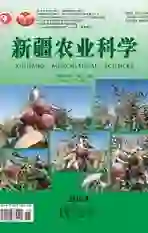设施蔬菜LED补光技术研究进展
2024-02-22马艳肖林刚喻晨郭兆峰邹平曹新伟
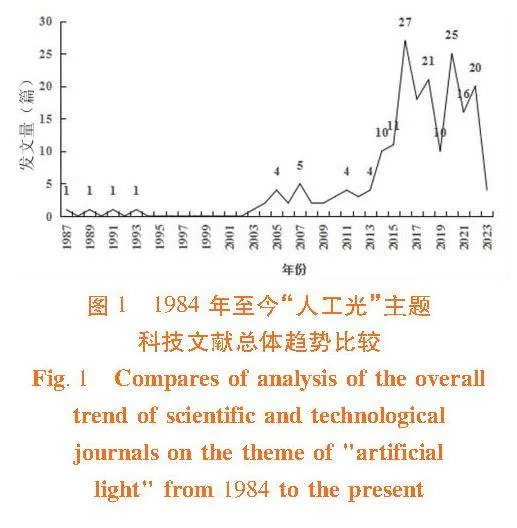
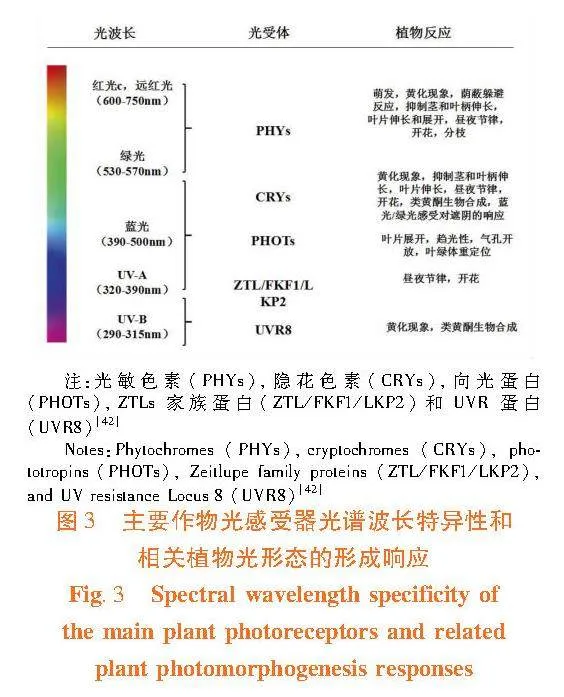
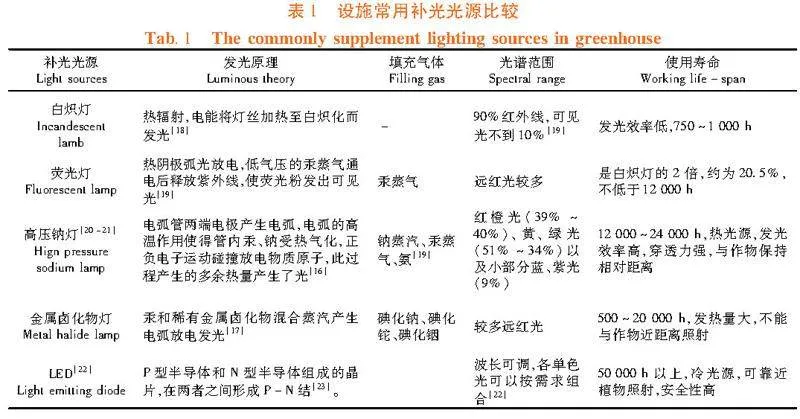
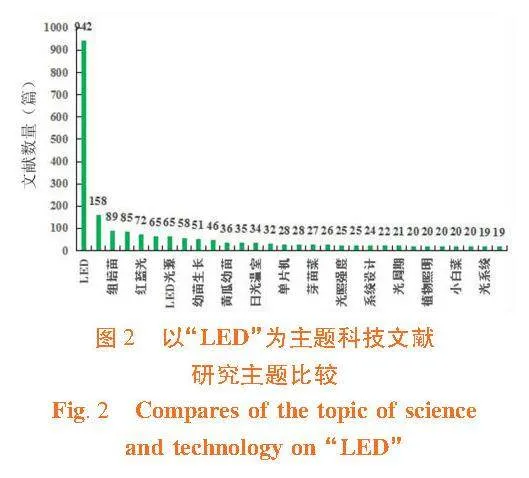
摘"要:【目的】""汇总分析国内外蔬菜LED补光技术研究现状和进展,为LED补光技术在我国设施蔬菜高效生产中的应用提供理论依据。
【方法】""收集查阅国内外文献资料,整理汇总并进行分析。
【结果】""LED光源是设施农业生产的理想光源,适宜的光配方(光质、光照强度、光照时间以及日累计光照量)可显著提升设施蔬菜幼苗干物质量和壮苗指数。长季节栽培顶部和株间补光可改善冠层光分布,增强植株整体光合作用。通过将补光方式与栽培环境参数相结合进行光环境动态精准调控实现设施蔬菜绿色优质高效生产有效途径。
【结论】""人工补光是改善温室光照环境、解决冬季设施蔬菜生产弱光和光照时间不足等不利光因素的有效方式,优化光配方与蔬菜品种和栽培环境,可综合提升设施蔬菜生产效能。
关键词:""设施蔬菜;LED补光;光质;光照强度;光周期
中图分类号:"S626.5""""文献标志码:"A""""文章编号:"1001-4330(2024)11-2835-09
0"引 言
【研究意义】2022年我国设施园艺总面积达280×104 hm2(4 200多万亩),占世界设施农业总面积的85%以上[1]。设施蔬菜是我国设施园艺产业主栽作物种类(种植面积占81%)[2],光环境是影响蔬菜生长发育的重要环境因子,在促进蔬菜作物生长、增加光合效率,提升作物产量方面发挥至关重要的作用。日光温室是我国特有的一种设施类型[3],设施内由于覆盖材料、结构等影响,室内光照强度大约为露地的30%~70%[4],冬春季节温室蔬菜生产需覆盖保温被或二道幕以满足作物对温度需求,不利的天气状况以及保温被未能及时卷起导致设施内长时间光照强度不足[5-6],易形成苗期徒长苗,开花坐果期蔬菜落花落果,果实着色不均匀等[7],严重影响蔬菜品质和产量。设施蔬菜冬季生产通过人工补光改善温室内光照环境,是解决弱光和光照时间不足等不利光环境的有效方式。通过对国内外设施蔬菜LED补光技术和研究动态进行分析,总结我国设施蔬菜LED补光技术最新研究进展,对选择设施高效补光方向有实际意义。【前人研究进展】LED(Light Emitting Diode,发光二极管)作为一种节能环保型光源,其具有光质和光量精确可调,能耗低、寿命长并且发热低(冷光源性)[8],且具防潮性和节能环保,作为设施农业生产应用的理想光源,近几年在设施蔬菜补光生产中应用相关文献较多[9-13]。【本研究切入点】当前LED补光技术在设施蔬菜育苗以及成株期的光配方(补光光质、光照强度和补光时间等)方面已有文献研究,但是对于光配方与蔬菜生长环境以及针对不同品种蔬菜作物在不同生长阶段的光配方动态调整策略尚未完全清晰,需综述分析LED光配方以及日累积光照量对设施蔬菜育苗期、成株期作物生理生化反应、补光方式(顶部补光和株间补光)以及智能化补光策略的最新进展。【拟解决的关键问题】收集、整理和分析国内外设施蔬菜LED补光技术研究进展,分析当前设施LED补光技术现状,为冬春季节设施蔬菜光能高效利用提供思路和参考。
1"材料与方法
1.1"材 料
收集和查阅当前国内外文献和官网相关设施蔬菜LED补光技术研究现状和进展。
1.2"方 法
整理汇总并分析归类设施蔬菜育苗期、成株期光配方以及补光策略研究现状及进展。
2"结果与分析
2.1"设施人工补光光源比较
研究表明,人工光环境调控作为设施农业生产的重要组成部分,广泛应用于植物光合补光、菌藻生产及病虫害防控等领域。当前设施人工补光光源主要有白炽灯、荧光灯[14]、高压钠灯[15-16]、金属卤化物灯[17]、LED灯[18]等。表1
在中国知网文献检索平台,检索1987至今以“人工光”为主题的科技文献,共检索到与农业领域相关的科技论文305篇,其中农作物、农艺学、园艺、农业基础科学和农业工程学科分别为115篇(占37.70%)、86篇(占28.20%)、81篇(占26.56%)、17篇(占5.57%)和6篇(1.97%)。发文量在2013年以前均在5篇以内,从2014年(10篇)开始逐年增加,2016年发文量为最多27篇,“十三五”(2016~2020年)期间发文量为100篇,占总发文量的50.50%,该趋势与“十三五”期间农业科技创新领域开展农业生产环境及植物本体感知数据采集、积累以及动植物表型及数学建模方法研究等基础研究方向相匹配[24]。图1
检索以“LED”为主题科技文献,共检索到与农业领域相关的科技论文2 132篇,研究主要集中在LED光源、光合特性、植物工厂、LED光质、生长发育和生理特性、光照强度等方面。图2
2.2"LED技术在设施生产中的应用
研究表明,LED灯可发出植物生长所需要的单色光光谱[22],并能根据生产所需实现波长和光照强度单独控制,光能有效利用率达80%~90%,传统人工光源光谱范围与植物实际所需的红光(600~700 nm)或蓝光(400~500 nm)相比范围更大[25]。
2.2.1"LED补光对蔬菜幼苗生长的影响
研究表明,设施育苗生产的光环境调控主要包括对光质、光照强度和光照周期的调控,对蔬菜日累积光照量(Daily Light Integral,DLI)的研究也日益增加[26-29]。
2.2.1.1"LED补光光质对蔬菜幼苗生长的影响
研究表明,光质是影响植物生长和发育的重要因素,光质由不同辐射光谱组成,植物主要利用的光谱范围在200~800 nm,可见光光谱中波长640~660 nm的红光和430~450 nm蓝光是光合作用主要光源[30]。相对于光照强度和光照时间,光质对植物生长发育的影响更加复杂。光质是通过触发基因表达调控植物生长发育的重要转导信号[31-33]。蓝光照射上调乙醇酸氧化酶(Glycolate oxidase, GLO2)和1,5-二磷酸核酮糖羧化酶大亚基(Ribulose-1,5-bisphosphate carboxylase-oxygenase large subunit , rbcL)基因表达,红光照射下调GLO2和rbcL基因表达,GLO2和rbcL均涉及到光呼吸和卡尔文循环的平衡调节[34]。单色光补充时,红光有利于植株叶片伸长和叶片叶面积、鲜重增加[35-36],可使黄瓜幼苗真叶数增多,提高叶片叶绿素相对含量,并且使番茄幼苗根长增加[37]。而蓝光有抑制叶片扩大的作用[38],会引起黄瓜叶片增厚和卷曲,使番茄植株幼苗株高显著降低[37]。远红光能够穿透植物冠层,适当增加远红光比例可以提升包括番茄在内的植物生长和产量[39]。与补充单色光质相比,红蓝复合光质可显著提高番茄幼苗干物质量、壮苗指数和净光合速率[40-41]。图3
绿光可以逆转红光或蓝光在生长发育产生的影响,并且通过触发特定基因的表达,增强作物对生物和非生物胁迫的抗性[37,43]。补充绿光时能够上调光合相关基因表达对维持光合能力具有正向调控作用[44],蓝光可通过激活质膜H+-ATPases刺激气孔开放,而绿光可以逆转由蓝光介导的气孔开放[45]。进行番茄苗期短期干旱胁迫处理,短期干旱胁迫下,增加绿光可以显著降低气孔导度(stomatal conductance,gs),增加原有和瞬时水分生产效率,同时增强叶肉导度(mesophyll conductance,gm),保持相对高的光合能力,并且可下调SLHA1,SLHA 2和SLHA 4表达,激活SLAREB1-2信号通路,从而引发植物抗旱[43]。
2.2.1.2"LED补光光强对蔬菜幼苗生长的影响
研究表明,日光温室冬春季节育苗由于光照强度低,幼苗茎秆瘦弱、株高增加,导致幼苗成苗质量不高[46-47]。番茄的光饱和点为1 250 μmol/(m2·s),光补偿点为35.7~44.6 μmol/(m2·s),黄瓜生长发育最适光照强度为600~900 μmol/(m2·s),光强低于100 μmol/(m2·s)则受到弱光胁迫[48]。在黄瓜开花坐果期若连续3~5 d光量子通量密度在20~100 μmol/(m2·s)范围内,弱光环境会造成黄瓜落花以及化瓜[49-50]。肖苏琪[46]研究发现早春季节补光强度为100 μmol/(m2·s)及以上时,有利于干物质向黄瓜幼苗叶片和根部的分配,不利于向茎部分配,并且不同光强补光处理黄瓜幼苗淀粉含量显著增加。白天以300 μmol/(m2·s)光照强度连续照射番茄叶片12 h后,夜间采用白光连续照射可损伤番茄叶片。与不补光相比,夜间采用150 μmol/(m2·s)光照强度的白光照射可促进番茄干物质积累,但与300 μmol/(m2·s)补光强度照射时无显著差异[51]。"
2.2.1.3"LED补光时间对蔬菜幼苗生长的影响
研究表明,王冰华[52]在研究揭苫前后温室补光对黄瓜幼苗的影响时发现,揭苫前3 h,或者盖苫前1 h和3 h补光有利于黄瓜幼苗总叶面积增加,全株干物质量的积累。邬奇等[53]研究表明,随着补光时间的延长,番茄幼苗叶片内源性玉米素(Zeatin,ZT)和吲哚乙酸(Indole-3-aceticacid,IAA)含量逐渐升高,而在茎中的含量逐渐降低,并且黄瓜幼苗叶面积与叶片IAA含量呈正相关,光周期可能通过调节内源性玉米素和生长素水平调控茎、叶面积和根系的生长发育,并且得出每天16 h光照有利于黄瓜和番茄幼苗根系生长发育,提高壮苗指数。
2.2.1.4"LED日累积光照量对蔬菜幼苗生长的影响"
研究表明,日累积光照量(DLI),是光照强度和光周期的乘积[26]。在人工光型植物工厂进行番茄育苗补光试验结果表明,适当提高DLI可促进幼苗生根,提高种苗健壮程度。以R:B为1.2的白红LED为补光光源,DLI为12.6 mol/(m2·d)(即光强为250 μmol/(m2·s),光照时间14 h)可作为设施番茄育苗的光环境调控依据[26]。光照强度和光照周对人工光型植物工厂水培草莓匍匐茎、子苗生长有交互作用:过高的日累积光照量会影响草莓子苗生长,可能是与不同草莓品种叶片的光饱和点及生长阶段相关,得出DLI为11.5 mol/(m2·d)(光照强度为200 μmol/(m2·s),补光时间16 h)光照环境较适宜“红颜”草莓匍匐茎育苗[54]。光照强度为30 μmol/(m2·s),光周期8 h/d处理的大豆芽苗菜下胚轴总酚类物质含量和DPPH自由基清除能力较黑暗培养处理和12 h/d光周期处理的效果显著更好[55]。采用绿光∶"蓝光∶"红光1∶"1∶"3光质,顶部补光光强约为11.16 μmol/(m2·s),补光9 h(08:00~17:00),可以增加日光温室马铃薯微型薯(11~20 g,21~30 g,31~40 g,微型马铃薯等级)生产的数量和质量[10]。不同蔬菜作物在不同生长阶段对光照强度和光周期的需求量不同。因此,在进行LED补光时要根据作物生长的具体环境制定相适应的补光策略以达到最佳补光效果。
2.2.2"LED补光对蔬菜成株生长应用的影响
研究表明,日光温室长季节吊蔓作物(包括荷兰立架式无土栽培系统),冠层垂直方向光照不均匀,植株中部及中下部光照环境远不如上层,严重影响植株整体光合产物合成和转运[54,56]。研究表明,黄瓜中层叶片所照射到光照强度仅为上层的30%[57]。由于LED具有冷光源性,可将其置于植株冠层下部空间进行株间补光或冠层顶部补光,从而改善了冠层光分布,增强植株整体光合作用[39,57],提高番茄地上部总干质量,增加10%~20%的作物产量[58],以LED灯为光源在日光温室番茄[7,59-60]、草莓[9]、黄瓜[29]、甜椒[9,61-62]、甜瓜[4]等作物株间补光的应用研究日益增加。番茄生长期、开花期、坐果期使用蓝光或红光、红蓝7∶"1以及红光或红蓝5∶"1进行顶部补光可有效增强番茄光合作用[12]。以红蓝5∶"1为补光光质,在冬季日光温室开棚前3 h和闭棚后3 h进行补光(补光6 h),300 μmol/(m2·s)补光光强相较于100 μmol/(m2·s)和200 μmol/(m2·s)更有利于番茄光合色素积累,叶绿素a、类胡萝卜素、叶绿素(a+b)含量也相对较高[63],而在早春季节番茄坐果后-果实转色期内采用叶背补光,揭帘前与盖帘后以200 μmol/(m2·s)光强补光,番茄果实可溶性固形物含量、总酸含量、VC含量、番茄红素和挥发性物质含量较高[54]。采用红蓝3∶"1进行番茄株间补光,当补光强度为170 μmol/(m2·s)(灯下30 cm处光照强度),补光16 h(08:00~00:00),补光灯放置于距番茄茎部水平30 cm处的冠层内部时,研究发现,株间补光可促进果实成熟,春季(3月11至6月21日)可提前一周成熟,夏季(6月22日至9月23日)可提前两周成熟[64]。
通过隶属函数对甜瓜不同生育期(幼苗期、伸蔓期和结果期)生理生长指标以及果实品质进行综合评价,得出幼苗期适宜补光7 h,伸蔓期进行5 h可促进植株生长,结果期补光1h(光照强度约为695.6~724.6 μmol/(m2·s))甜瓜果实品质最佳,产量也最高[4]。
2.2.3"设施蔬菜LED补光策略
研究表明,针对不同作物或同种作物在不同生长阶段对光照强度的差异性需求进行精准化补光是提升蔬菜作物光合利用效率、实现优质高产的关键途径。采用升降式补光系统可实现作物生育期对不同光照强度的需求[65]。但当前蔬菜补光大多采用固定光质、光照强度方式进行补光,由于经验值和作物实际需求存在一定差异,使得补光过程未能形成标准化、精准化方案[66]。针对不同植物在不同生长阶段对光配方(光质、光照强度和光周期)需求的不同,通过采集温室光照、温度以及CO2等参数,构建温室作物补光数学模型以及最佳红蓝光阈值[67-68],建立智能补光系统,可实现温室作物自动化补光,可节能10%。张仲熊等[69]采用冠层补光和株间补光2种方式相结合的立体补光方式,充分采集作物冠层-株间实时环境数据,通过冠层-株间光环境调控模型获得黄瓜种植过程所需的光强值,动态计算冠层-株间补光灯所需要停留的位置,采用ZigBee无线传输,进行补光灯升降装置高度实时变化,从而达到黄瓜种植整体光环境精准实时调控,与传统冠层补光以及自然光相比,立体补光区黄瓜产量分别比前两者增加0.28和1.39 kg/m2。
3"讨 论
3.1"""LED灯作为新型固态半导体光源,可以根据作物生理生长需求进行智能化的光照环境控制,从实现蔬菜作物标准化种植[70],我国蔬菜种植区气候类型多样,且蔬菜品种多样,在进行设施蔬菜补光时,应针对不同种植区,不同蔬菜品种构建适宜的补光措施。例如在设施冬春季节生产时,大多选择耐弱光、耐低温、抗病品种,而针对耐弱光品种补光(光饱和点、补偿点)策略与常规品种的差异还需要研究。《温室植物补光灯质量评价技术规范》[71]对植物生长灯用的LED灯的质量进行评定,针对不同气候区设施作物种植补光参数仍需明确。
3.2
当前针对设施蔬菜智能补光策略将环境参数(温度、CO2等)与植物光配方需求相结合,通过构建相适应的数学模型,利用农业物联网技术实现温室作物动态自动补光已有研究,但一些研究结果还处于试验阶段[69],仍需要进行长期跟踪试验。针对作物冠层补光+株间补光方式,搭建与相适应的自动化补光系统,构建系统性的智能补光策略,充分挖掘作物光合利用效能,提升作物品质和产量,将为设施农业提质增效提供有效解决方案。
3.3
作为一种生产环境稳定,能够智能化周年稳定生产方式,植物工厂成为近几年发展迅猛的行业,而缺乏高效率、低价格LED光源市场提供成为限制人工光型植物工厂产业化发展的关键问题之一。前人研究指出人工型植物工厂的光能利用效率理论最大值为0.1[72],而实际种植生产中光能利用效率大概在0.032~0.043,远未达到理论最大值[26];其次LED光源前期购买投入较大,例如功率为15W的LED补光灯每只灯管价格大约120元,远高于普通光源灯(飞利浦荧光灯,16W或20W每只灯管价格约在15~20元)。因此,研发或筛选适宜的性价比较高的LED灯具以满足植物工厂育苗或栽培工艺至关重要。
4"结 论
4.1
综述了补光技术在设施蔬菜育苗期和成株期生长研究进展,总结分析光配方(光质、光照强度、光照时间、日累计光照量)对幼苗生理生长以及成株期果实产量和品质的影响。针对不同蔬菜作物品种需要深入研究光配方复合因素对设施蔬菜栽培影响机制,综合提升蔬菜作物光能利用率。
4.2"""LED补光对设施育苗壮苗提升、成株产量品质提升具有促进作用。将LED补光与具体栽培环境参数(温度、CO2、湿度等)相结合,通过多因子耦合分析,需要明确光配方随温室环境参数动态调整机制,针对不同补光方式研发智能化、精准化补光体系,从而实现设施蔬菜高效补光。
参考文献"(References)
[1]"李天来, 齐明芳, 孟思达.中国设施园艺发展60年成就与展望[J].园艺学报, 2022, 49(10): 2119-2130.
LI Tianlai, QI Mingfang, MENG Sida.Sixty years of facility horticulture development in China: achievements and prospects[J].Acta Horticulturae Sinica, 2022, 49(10): 2119-2130.
[2] 齐飞.在历史的回望中走进新时代——设施园艺产业四十年变革与发展[J].农业工程技术, 2019, 39(25): 15-17.
QI Fei.In the historical retrospection into a new era -- the 40 years of change and development of facility horticulture industry [J].Agricultural Engineering Technology, 2019, 39(25): 15-17.
[3] 周莹.日光温室复合相变保温材料的研究[D].太谷: 山西农业大学, 2017.
ZHOU Ying."Study on Composite Phase Change Thermal Insulation Material in Solar Greenhouse[D].Taigu: Shanxi Agricultural University, 2017.
[4] 祁娟霞, 韦峰, 董艳, 等.不同补光时间对日光温室甜瓜生长发育的影响[J].浙江农业学报, 2016, 28(6): 979-983.
QI Juanxia, WEI Feng, DONG Yan, et al.Effect of different duration of supplemental illumination on growth of melon in sunlight greenhouse[J].Acta Agriculturae Zhejiangensis, 2016, 28(6): 979-983.
[5] 杨小玲, 宋兰芳, 靳力争, 等.设施果菜补光技术应用现状与展望[J].北方园艺, 2018,(17): 166-170.
YANG Xiaoling, SONG Lanfang, JIN Lizheng, et al.Application status and prospect of supplemental lighting in cultivation of vegetables and fruits in greenhouse[J].Northern Horticulture, 2018,(17): 166-170.
[6] 王楠, 焦子伟, 李东育, 等.我国绿色设施农业栽培关键技术研究进展[J].江苏农业科学, 2021, 49(18): 18-24.
WANG Nan, Jiao Ziwei, Li Dongyu, et al.Research progress on key cultivation technology of China’s green facility agriculture[J].Jiangsu Agricultural Sciences, 2021, 49(18): 18-24.
[7] 刘文科.LED补光对日光温室番茄生长和产量的影响[J].农业工程技术, 2016, 36(4): 40-41.
LIU Wenke.Effect of LED fill-light on tomato growth and yield in greenhouse [J].Agricultural Engineering Technology, 2016, 36(4): 40-41.
[8] 杨雅婷, 魏灵玲, 魏强, 等.LED在设施园艺中的应用系列(五) LED在温室补光中的应用[J].农业工程技术(温室园艺), 2009, 29(9): 15-16.
YANG Yating, WEI Lingling, WEI Qiang, et al.The application of LED in greenhouse fill-light [J].Agriculture Engineering Technology (Greenhouse amp; Horticulture), 2009, 29(9): 15-16.
[9] 王华硕.LED补光对日光温室黄瓜、番茄、草莓生长发育及品质的影响[D].邯郸: 河北工程大学, 2018.
WANG Huashuo.Effect of LED Light on the Growth and Quality of Cucumber, Tomato and Strawberry in Solar Greenhouse[D].Handan: Hebei University of Engineering, 2018.
[10] 钱创建, 宿飞飞, 王绍鹏, 等.LED补光对日光温室脱毒马铃薯微型薯结薯特性的影响[J].中国瓜菜, 2021, 34(7): 54-57.
QIAN Chuangjian, SU Feifei, WANG Shaopeng, et al.Effect of LED lighting on the production characteristics of virus-free potato minituber in solar greenhouse[J].China Cucurbits and Vegetables, 2021, 34(7): 54-57.
[11] 傅国海, 杨其长, 刘文科.LED补光和根区加温对日光温室起垄内嵌式基质栽培甜椒生长及产量的影响[J].中国生态农业学报, 2017, 25(2): 230-238.
FU Guohai, YANG Qichang, LIU Wenke.Effect of LED supplemental lighting and root zone heating on growth and yield of soil ridged substrate-embedded sweet pepper in solar greenhouses in China[J].Chinese Journal of Eco-Agriculture, 2017, 25(2): 230-238.
[12] 卢纯, 张亚红, 李青.LED不同光质补光对日光温室冬春茬番茄生长及光合特性的影响[J].江苏农业科学, 2020, 48(8): 127-134.
LU Chun, Zhang Yahong, Li Qing.Effects of LED light quality supplements on growth and photosynthetic characteristics of tomatoes in winter-spring season in solar greenhouse[J].Jiangsu Agricultural Sciences, 2020, 48(8): 127-134.
[13] 卢纯.LED光质对冬季日光温室内番茄生产及病虫害的影响[D].银川: 宁夏大学, 2019.
LU Chun.Effects of Different LED Lights under Tomato’s Production, Diseases and Pests in Solar Greenhouse during Winter Season[D].Yinchuan: Ningxia University, 2019.
[14] 王伟伟, 马俊贵.设施温室补光灯的应用[J].农业工程, 2014, 4(6): 47-50.
WANG Weiwei, MA Jungui.Application of facilities greenhouse fill light[J].Agricultural Engineering, 2014, 4(6): 47-50.
[15] 耿博, 龙家焕, 郑梦影, 等.高压钠灯与LED灯在植物补光中的应用特性分析[J].黑龙江农业科学, 2018,(8): 65-69.
GENG Bo, LONG Jiahuan, ZHENG Mengying, et al.Analysis of application characteristics of high pressure sodium lamp and LED lamp in plant light supply[J].Heilongjiang Agricultural Sciences, 2018,(8): 65-69.
[16] 霍菲阳.高压钠灯用大功率电子镇流器的研究[D].哈尔滨: 哈尔滨理工大学, 2008.
HUO Feiyang.Research on Electronic Ballast Used for High Pressure Sodium Lamp[D].Harbin: Harbin University of Science and Technology, 2008.
[17] 姜青松, 王海波, 朱月华.金属卤化物灯及其发光材料的研究进展[J].中国照明电器, 2013,(10): 1-5.
JIANG Qingsong, WANG Haibo, ZHU Yuehua.Status and development on metal halide lamps and luminous materials[J].China Light amp; Lighting, 2013,(10): 1-5.
[18] 吕艳.温室设施的使用与维护系列之温室补光[J].农业工程技术(温室园艺), 2007, 27(12): 20, 19.
LYU Yan.The use and maintenance of greenhouse facilities series of greenhouse lighting [J].Agricultural Engineering Technology (Greenhouse amp; Horticulture), 2007, 27(12): 20, 19.
[19] 葛大勇.设施农业专用光源的研制[D].保定: 河北大学, 2001.
GE Dayong.Development of the Special light Source for Equipment Agriculture[D].Baoding: Hebei University, 2001.
[20] 尤杰, 耿博, 郑梦影, 等.设施园艺生产中LED灯与高压钠灯的应用差异性分析[J].农业工程技术, 2018, 38(7): 17-21.
YOU Jie, GENG Bo, ZHENG Mengying, et al. Application difference analysis of LED lamp and high pressure sodium lamp in facility horticulture production[J].Agricultural Engineering Technology, 2018, 38(7):17-21.
[21] 张理智.隧道高压钠灯与LED灯照明节能分析、比选[J].隧道建设, 2012, 32(S2): 18-23.
ZHANG Lizhi.Analysis on and comparsion and contrast between high pressure sodium lamps and LED lights [J].Tunnel Construction, 2012, 32(S2): 18-23.
[22] Singh D, Basu C, Meinhardt-Wollweber M, et al.LEDs for energy efficient greenhouse lighting[J].Renewable and Sustainable Energy Reviews, 2015, 49: 139-147.
[23] 刘文科, 杨其长, 魏灵玲.LED光源及其设施园艺应用[M]. 北京: 中国农业科学技术出版社, 2012.
LIU Wenke, YANG Qichang, WEI Lingling.Light-emitting diodes(LEDs) and their applications in protected horticulture as light sources[M]."China Agricultural Science and Technology Press, 2012.
[24] 李涛.国家重点研发计划“用于设施农业生产的LED关键技术研发与应用示范” 项目在京启动[J].农业工程技术, 2017, 37(31): 48-49.
LI Tao.The National Key Ramp;D Program \"LED Key Technology Ramp;D and Application Demonstration for Facility Agricultural Production\" project was launched in Beijing [J].Agricultural Engineering Technology, 2017, 37(31): 48-49.
[25] Voskresenskaya N P, Drozdova I S.Effect of light quality on the organization of photosynthetic electron transport chain of pea seedlings[J].Plant Physiology, 1977, 59(2): 151-154.
[26] 季方, 甘佩典, 刘男, 等.LED光质和日累积光照量对番茄种苗生长及能量利用效率的影响[J].农业工程学报, 2020, 36(22): 231-238.
JI Fang, GAN Peidian, LIU Nan, et al.Effects of LED spectrum and daily light integral on growth and energy use efficiency of tomato seedlings[J].Transactions of the Chinese Society of Agricultural Engineering, 2020, 36(22): 231-238.
[27] 崔佳维, 雷炳富, 刘厚诚.光合有效辐射日总量(DLI)对植物生长发育的影响[J].园艺学报, 2019, 46(9): 1670-1680.
CUI Jiawei, LEI Bingfu, LIU Houcheng.Effect of daily light integral on plant growth and development[J].Acta Horticulturae Sinica, 2019, 46(9): 1670-1680.
[28] Hernández R, Eguchi T, Deveci M, et al.Tomato seedling physiological responses under different percentages of blue and red photon flux ratios using LEDs and cool white fluorescent lamps[J].Scientia Horticulturae, 2016, 213: 270-280.
[29] 王绍辉, 孔云, 陈青君, 等.不同光质补光对日光温室黄瓜产量与品质的影响[J].中国生态农业学报, 2006, 14(4): 119-121.
WANG Shaohui, KONG Yun, CHEN Qingjun, et al.The effects of different light qualities on cucumber fruit quality and yield in greenhouse[J].Chinese Journal of Eco-Agriculture, 2006, 14(4): 119-121.
[30] 陈田甜.不同光质对番茄果实品质形成的影响[D].广州: 华南农业大学, 2016.
CHEN Tiantian.Effects of Light Quality on the Quality Formation of Tomato Fruits[D].Guangzhou: South China Agricultural University, 2016.
[31] Kami C, Lorrain S, Hornitschek P, et al.Chapter two light-regulated plant growth and development[J].Current Topics in Developmental Biology, 2010, 91: 29-66.
[32] Xu Y.Seven dimensions of light in regulating plant growth[J].Acta Horticulturae, 2016,1134: 445-452.
[33] Franklin K A, Whitelam G C.Light-quality regulation of freezing tolerance in Arabidopsis thaliana[J].Nature Genetics, 2007, 39(11): 1410-1413.
[34]Soghra Esmaelpour., Alireza Iranbakhsh., Kamaleddin Dilmaghani., Sayeh Jafari Marandi., Zahra Oraghi Ardebili.The potential contribution of the WRKY53 transcription factor, gamma-aminobutyric acid (GABA) transaminase, and histone deacetylase in regulating growth, organogenesis, photosynthesis, and transcriptional responses of tomato to different light-emitting diodes (LEDs)[J].Journal of Photochemistry and Photobiology B: Biology, 2022,229:112413.
[35] 邬奇, 苏娜娜, 崔瑾.LED光质补光对番茄幼苗生长及光合特性和抗氧化酶的影响[J].北方园艺, 2013,(21): 59-63.
WU Qi, SU Nana, CUI Jin.Effects of LED light quality on growth vitality, photosynthetic performance and antioxidant enzymatic activity of tomato seedlings[J].Northern Horticulture, 2013,(21): 59-63.
[36] 崔瑾, 马志虎, 徐志刚, 等.不同光质补光对黄瓜、辣椒和番茄幼苗生长及生理特性的影响[J].园艺学报, 2009, 36(5): 663-670.
CUI Jin, MA Zhihu, XU Zhigang, et al.Effects of supplemental lighting with different light qualities on growth and physiological characteristics of cucumber, pepper and tomato seedlings[J].Acta Horticulturae Sinica, 2009, 36(5): 663-670.
[37] 苏娜娜, 邬奇, 崔瑾.不同光质下黄瓜和番茄幼苗叶片光合特性和叶绿体超微结构分析[J].植物发育与细胞功能, 全国植物生物学大会, 2013.
SU Nana, WU qi, CU Jin.Photosynthetic activity and chlorplastic ultrastructure analysis of seedlings Cucumis sativus L.and Solanum lycopersicum cultivated under different light qualities[J].National Congress of Plant Biology, 2013.
[38] Li Q, Kubota C.Effects of supplemental light quality on growth and phytochemicals of baby leaf lettuce[J].Environmental and Experimental Botany, 2009, 67(1): 59-64.
[39] Kim H J, Yang T, Choi S, et al.Supplemental intracanopy far-red radiation to red LED light improves fruit quality attributes of greenhouse tomatoes[J].Scientia Horticulturae, 2020, 261: 108985.
[40] Macedo A F, Leal-Costa M V, Tavares E S, et al.The effect of light quality on leaf production and development of in vitro-cultured plants of Alternanthera brasiliana Kuntze[J].Environmental and Experimental Botany, 2011, 70(1): 43-50.
[41] 朱鹿坤, 陈俊琴, 赵雪雅, 等.红蓝绿LED延时补光对日光温室番茄育苗的影响[J].中国蔬菜, 2019,(10): 51-57.
ZHU Lukun, CHEN Junqin, ZHAO Xueya, et al.Effect of red, blue and green LED delayed supplementary lighting on tomato seedlings culture in solar greenhouse[J].China Vegetables, 2019,(10): 51-57.
[42] Paradiso R, Proietti S.Light-quality manipulation to control plant growth and photomorphogenesis in greenhouse horticulture: the state of the art and the opportunities of modern LED systems[J].Journal of Plant Growth Regulation, 2022, 41(2): 742-780.
[43] Bian Z H, Zhang X Y, Wang Y, et al.Improving drought tolerance by altering the photosynthetic rate and stomatal aperture via green light in tomato (Solanum lycopersicum L.) seedlings under drought conditions[J].Environmental and Experimental Botany, 2019, 167: 103844.
[44] Bian Z H, Cheng R F, Wang Y, et al.Effect of green light on nitrate reduction and edible quality of hydroponically grown lettuce (Lactuca sativa L.) under short-term continuous light from red and blue light-emitting diodes[J].Environmental and Experimental Botany, 2018, 153: 63-71.
[45] Kinoshita T.Blue light activates the plasma membrane H+-ATPase by phosphorylation of the C-terminus in stomatal guard cells[J].The EMBO Journal, 1999, 18(20): 5548-5558.
[46] 肖苏琪, 王冰华, 曲梅, 等.冬春季节育苗温室补光光强对黄瓜幼苗质量的影响[J].中国蔬菜, 2018,(10): 40-45.
XIAO Suqi, WANG Binghua, QU Mei, et al.Effect of supplementary light intensity on quality of winter-spring cucumber seedling in solar greenhouse[J].China Vegetables, 2018,(10): 40-45.
[47] 王俊玲.番茄光合的光谱效应研究[D].保定: 河北农业大学, 2015.
WANG Junling.Effect of Spectra on Photosynthesis in Tomato[D].Baoding: Hebei Agricultural University, 2015.
[48] 山东农业大学.蔬菜栽培学各论: 北方本(2版)[M]. 北京: 农业出版社, 1987.
Shandong Agricultural University.Various Theories of Vegetable Cultivation (The second print)[M]."Beijing: China Agricultural Press, 1987.
[49] 余纪柱, 安红伟, 李建吾, 等.弱光下黄瓜苗期性状的遗传分析[J].上海农业学报, 2004, 20(4): 20-24.
YU Jizhu, AN Hongwei, LI Jianwu, et al.Genetic analysis for cucumber seedling characters under low light conditions[J].Acta Agriculturae Shanghai, 2004, 20(4): 20-24.
[50] 周艳虹, 黄黎锋, 喻景权.持续低温弱光对黄瓜叶片气体交换、叶绿素荧光猝灭和吸收光能分配的影响[J].植物生理与分子生物学学报, 2004, 30(2): 153-160.
ZHOU Yanhong, HUANG Lifeng, YU Jingquan.Effects of sustained chilling and low light on gas exchange, chlorophyll fluorescence quenching and absorbed light allocation in cucumber leaves[J].Acta Photophysiologica Sinica, 2004, 30(2): 153-160.
[51] Matsuda R, Yamano T, Murakami K, et al.Effects of spectral distribution and photosynthetic photon flux density for overnight LED light irradiation on tomato seedling growth and leaf injury[J].Scientia Horticulturae, 2016, 198: 363-369.
[52] 王冰华, 孙风清, 李娟起, 等.不同时段补光对日光温室冬春茬黄瓜幼苗质量的影响[J].中国蔬菜, 2017,(12): 23-29.
WANG Binghua, SUN Fengqing, LI Juanqi, et al.Effects of supplementary light at different time on quality of cucumber seedlings in solar greenhouse[J].China Vegetables, 2017,(12): 23-29.
[53] 邬奇, 苏娜娜, 崔瑾.不同光周期下黄瓜和番茄幼苗生长与ZT和IAA的相关性[J].园艺学报, 2013, 40(4): 755-761.
WU Qi, SU Nana, CUI Jin.The correlation between endogenous ZT and IAA contents with the growth of cucumber and tomato seedlings under different photoperiod[J].Acta Horticulturae Sinica, 2013, 40(4): 755-761.
[54] Jiang C Y, Johkan M, Hohjo M, et al.Photosynthesis, plant growth, and fruit production of single-truss tomato improves with supplemental lighting provided from underneath or within the inner canopy[J].Scientia Horticulturae, 2017, 222: 221-229.
[55] 齐学会, 张晓燕, 鲁燕舞, 等.光质和光周期对大豆芽苗菜生长及总酚类物质含量的影响[J].中国蔬菜, 2014,(7): 29-34.
QI Xuehui, ZHANG Xiaoyan, LU Yanwu, et al.Effects of light quality and photoperiod on growth and total phenolics content of soybean sprouts[J].China Vegetables, 2014,(7): 29-34.
[56] 闫文凯, 张雅婷, 张玉琪, 等.LED株间补光对日光温室番茄产量及光合作用的影响[J].西北农林科技大学学报(自然科学版), 2018, 46(7): 132-138, 146.
YAN Wenkai, ZHANG Yating, ZHANG Yuqi, et al.Effects of LED interlighting on yield and photosynthesis of tomato in solar greenhouse[J].Journal of Northwest A amp; F University (Natural Science Edition), 2018, 46(7): 132-138, 146.
[57] Trouwborst G, Oosterkamp J, Hogewoning S W, et al.The responses of light interception, photosynthesis and fruit yield of cucumber to LED-lighting within the canopy[J].Physiologia Plantarum, 2010, 138(3): 289-300.
[58] Groher T, Rhlen-Schmittgen S, Fiebig A, et al.Influence of supplementary LED lighting on physiological and biochemical parameters of tomato (Solanum lycopersicum L.) leaves[J].Scientia Horticulturae, 2019, 250: 154-158.
[59] 宋羽.株间LED补光与温室番茄光能利用特性及生长发育关系的研究[D].北京: 中国农业大学, 2017.
SONG Yu.Study on the Relationship among the Inter Supplemental LED and the Light Utilization Characteristics, the Plant Growth-and-development of Tomato Produced in Greenhouse[D].Beijing: China Agricultural University, 2017.
[60] Fanwoua J, Vercambre G, Buck-Sorlin G, et al.Supplemental LED lighting affects the dynamics of tomato fruit growth and composition[J].Scientia Horticulturae, 2019, 256: 108571.
[61] 段青青, 张禄祺, 张自坤, 等.补光时间及光质对温室甜椒生长及产量品质的影响[J].农业工程学报, 2019, 35(24): 213-222.
DUAN Qingqing, ZHANG Luqi, ZHANG Zikun, et al.Effects of spectrum and duration of supplemental illumination on growth, yield and fruit quality of greenhouse sweet pepper[J].Transactions of the Chinese Society of Agricultural Engineering, 2019, 35(24): 213-222.
[62] 王翠丽, 赵旭, 赵鹏, 等.不同补光灯对日光温室辣椒生长发育及品质的影响[J].福建农业学报, 2019, 34(9): 1047-1052.
WANG Cuili, ZHAO Xu, ZHAO Peng, et al.Effects of supplemental light on growth, physiology, and quality of chili peppers cultivated in solar greenhouse[J].Fujian Journal of Agricultural Sciences, 2019, 34(9): 1047-1052.
[63] 黄松, 刘勇鹏, 孙凯乐, 等.不同LED光强补光对日光温室越冬番茄生长及产量品质的影响[J].山东农业科学, 2023, 55(6): 62-68.
HUANG Song, LIU Yongpeng, SUN Kaile, et al.Effects of different LED light intensities on growth, yield and quality of overwintering tomato in solar greenhouse[J].Shandong Agricultural Sciences, 2023, 55(6): 62-68.
[64]Ivan Paucek, Giuseppina Pennisi, Alessandro Pistillo, et al.Supplementary LED interlighting improves yield and precocity of greenhouse tomatoes in the Mediterranean[J].Agronomy, 2020,10(7):1002.
[65] 张彩虹, 于秀针, 马彩雯, 等.升降式系统补光对弱光条件下日光温室番茄生长及产量品质的影响[J].中国农机化学报, 2017, 38(7): 54-58.
ZHANG Caihong, YU Xiuzhen, MA Caiwen, et al.Effects of lifting supplementary lighting on growth, quality and yield of tomato with weak light in greenhouse[J].Journal of Chinese Agricultural Mechanization, 2017, 38(7): 54-58.
[66] 胡瑾.基于作物光合需求的设施光环境调控方法与技术研究[D].杨凌: 西北农林科技大学, 2016.
HU Jin.Research on Method and Technology of Light Environment Control of Facility Based on Crop Photosynthetic Demand[D].Yangling: Northwest A amp; F University, 2016.
[67] 李晋蒲, 曹瑞红, 赵建贵, 等.基于LoRa的温室智能补光系统研制[J].江苏农业科学, 2020, 48(5): 198-204.
LI Jinpu, Cao Ruihong, Zhao Jiangui, et al.Development of greenhouse intelligent fill light system based on LoRa[J].Jiangsu Agricultural Sciences, 2020, 48(5): 198-204.
[68] 程鑫, 徐晓辉, 宋涛, 等.基于PSO-SVR模型的温室智能补光系统研究[J].中国农机化学报, 2020, 41(6): 64-68, 82.
CHENG Xin, XU Xiaohui, SONG Tao, et al.Research on intelligent light-filling system in greenhouse based on PSO-SVR model[J].Journal of Chinese Agricultural Mechanization, 2020, 41(6): 64-68, 82.
[69] 张仲雄, 李斌, 冯盼, 等.基于植株需光差异特性的设施黄瓜立体光环境智能调控系统[J].智慧农业(中英文), 2020, 2(2): 94-104.
ZHANG Zhongxiong, LI Bin, FENG Pan, et al.Stereoscopic light environment intelligent control system based on characteristic differences of facility cucumber plants light requirements[J].Smart Agriculture, 2020, 2(2): 94-104.
[70] 谭杰挥, 刘厚诚.植物工厂蔬菜育苗光调控技术研究进展[J].农业工程技术, 2022, 42(1): 24-29.
TAN Jiehui, LIU Houcheng.Research progress on light control technology for vegetable seedlings in plant factories [J].Agricultural Engineering Technology, 2022, 42(1): 24-29.
[71] NY/T 3657-2020.温室植物补光灯质量评价技术规范 [S].
NY/T 3657-2020.Technical specification of quality evaluation for plant lamps of supplement lighting in greenhouse [S].
[72] Kozai T.Resource use efficiency of closed plant production system with artificial light: Concept, estimation and application to plant factory[J].Proceedings of the Japan Academy, Series B, 2013, 89(10): 447-461.
Research progress of LED light supplement technology ""of greenhouse vegetables
MA Yan, XIAO Lingang, YU Chen, GUO Zhaofeng, ZOU Ping, CAO Xinwei
(Institute of Agricultural Mechanization, Xinjiang Academy of Agricultural Sciences/Key Laboratory of Intelligent Control Technology for Xinjiang Facility Agriculture, Urumqi 830091, China)
Abstract:【Objective】 ""To summarize and analyze the research status and progress of LED supplementation technology for vegetables at home and abroad in the hope of providing a theoretical basis for the application of LED fill light technology in the efficient production of facility vegetables in China.
【Methods】 """Related literature in domestic and foreign were collected , and meanwhile, these literature were sorted and analyzed.
【Results】 ""LED light source was an ideal light source for facility agricultural production, appropriate light formula (light quality, light intensity and light duration and cumulative daily light amount) could significantly improve the dry matter quality and strong seedlings index of vegetables seedling.Light supplementation at the top and between plants could improve the canopy light distribution and enhance the overall photoeynthesis of plants in long season cultivation.It was an effective way to accurately control the dynamic light environment by combining the light filling method with the cultivation environment parameters to achieve green, high quality and efficient production of facility vegetables.
【Conclusion】 ""Artificial light supplementation is an effective way to improve the greenhouse light environment and solve the unfavorable light factors such as weak light and insufficient light time in winter vegetable production.Through the combination of light formula, vegetable varieties and cultivation environment optimization, the production efficiency of vegetable facilities can be comprehensively improved.
Key words:""greenhouse vegetables; LED light supplement; light quality; light intensity; photoperiod
Fund projects:""Special Training Project for Xinjiang Minority Science and Technology Talents \"Study on the automatic LED Light Supplementation of tomato seedling in Greenhouse\"(2019D03008); Funding Project of Basic Scientific Research Business of Public Welfare Scientific Research Institutes in Autonomous Region\"Research on structural optimization and efficient cultivation technology of arch shed in southern Xinjiang\"(KY2021129);Xinjiang Academy of Agricultural Sciences independent cultivation project \"Research and application of digitization of production technology in facility agriculture\"(nkyzzkj-025)
Correspondence author:""CAO Xinwei(1982- ), male, senior engineer,master, "research direction: facility agriculture engineering technology and equipment, (E-mail) caoxinwei@sohu.com
ZOU Ping(1977-), male, professor of engineering,master, "research direction:facility agriculture engineering technology, (E-mail)75066472@qq.com
收稿日期(Received):
2024-05-17
基金项目:
新疆少数民族科技人才特殊培养计划项目“设施番茄苗期 LED 自动补光工艺研究”(2019D03008);新疆维吾尔自治区公益性科研院所基本科研业务经费资助项目“南疆拱棚结构优化及高效栽培技术研究”(KY2021129);新疆农业科学院自主培育项目“设施农业生产技术数字化的研究应用”(nkyzzkj-025)
作者简介:
马艳(1987-),女,新疆人,高级农艺师,硕士,研究方向设施蔬菜栽培生理,(E-mail)455618932@qq.com
通讯作者:
曹新伟(1982-),男,湖南人,高级工程师,硕士,研究方向设施农业工程技术与装备,(E-mail)caoxinwei@sohu.com
邹平(1977-),男,江西人,正高级工程师,硕士,研究方向设施农业工程技术,(E-mail)75066472@qq.com
